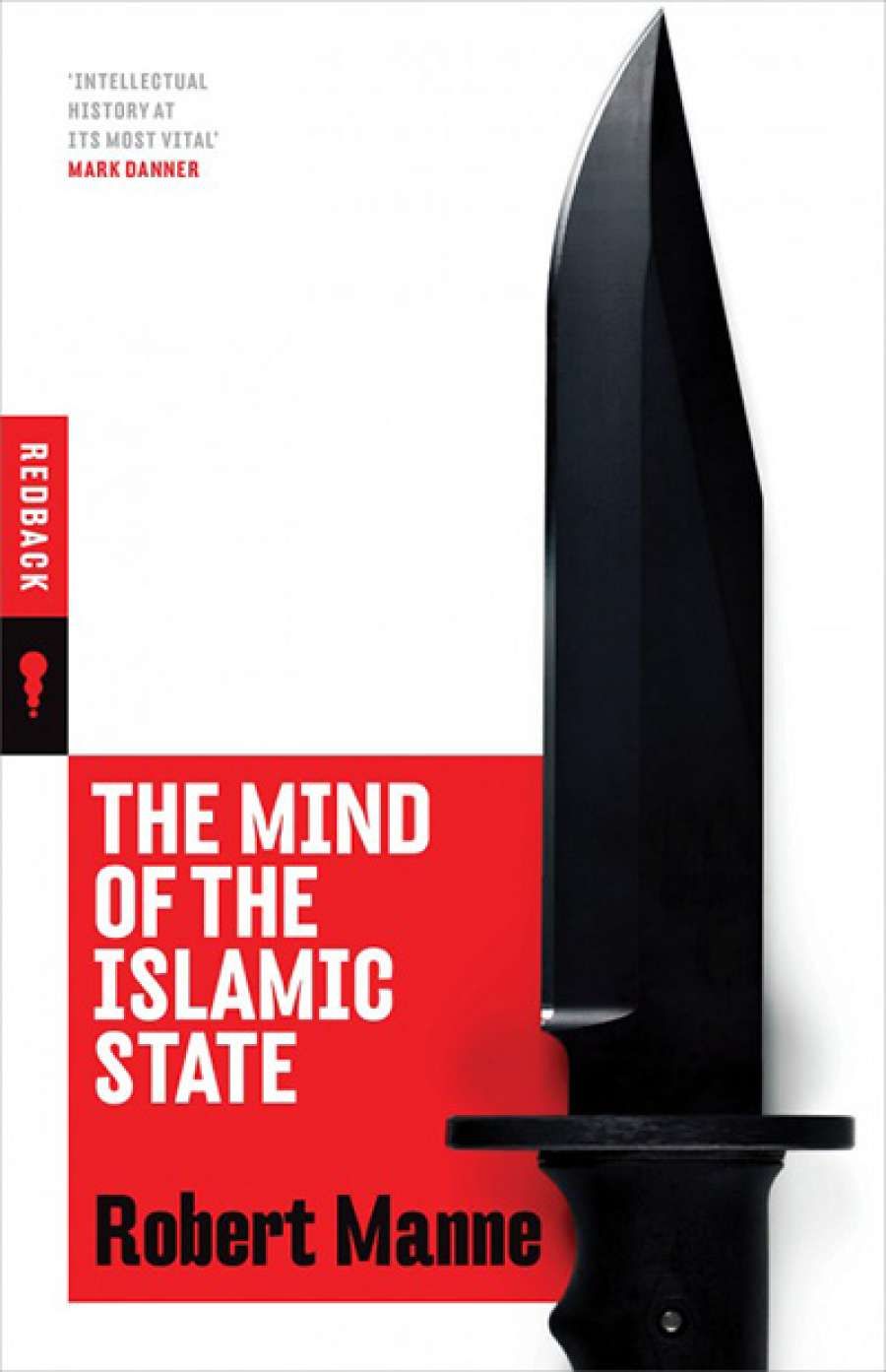
- Free Article: No
- Contents Category: Politics
- Custom Article Title: Michael Winkler reviews 'The Mind of the Islamic State' by Robert Manne
- Book 1 Title: The Mind of the Islamic State
- Book 1 Biblio: Redback, $22.99 pb, 186 pp, 9781863958813
Qutb was hanged in 1966, but his promotion of hakimiyya – the idea that sovereignty can never belong to the state but only to God – and vigorous anti-Semitism infected a number of intellectual successors. Manne shows how texts by post-Qutb authors have driven the ‘progressive radicalisation or brutalisation of both the Salafi jihadist ideology and the behaviour of its adherents’. Each tome is more extreme than the last. Part justification, part battle-plan, these texts provided a ‘new jurisprudence and ethic of jihad’ for a ‘new hardened and brutalised psychological type’ of fanatic.
It is difficult to reconcile the crudity of these authors’ monocular Manichaeism, troglodyte sexual politics, and grotesque Jew-baiting with the sophistication of the intricate theological arguments employed as underpinning. Every declaration, however brutish, is tied to abstruse parsing or press-ganging of hadiths or Qur’an passages.
Ayman al-Zawahiri found a way around Islam’s apparent condemnation of suicide to legitimise the jihadist suicide bomber, so ‘the warrior is fused with the martyr in a way that licenses a new form of attack’. Abu Bakr Naji ordered punishment ‘with the utmost coarseness and ugliness’. Overturning the dictate against killing other members of the faith, Abu Musab al-Zarqawi advocated killing Shi’a Muslims, labelling them ‘the most vile people in the human race ... the prowling serpent, the crafty evil scorpion, the enemy lying in wait’. These statements are pavers on the path towards contemporary Islamic State’s worldview of extreme violence towards a startlingly broad range of perceived enemies.
According to Manne, this radical descent has taken Islamic State to the Gates of Hell. The requisite reading material at this destination is the online magazine Dabiq, ‘an indispensable source for an understanding of the ideology of the Islamic State’. Dabiq is a slick and sickening combination of modern graphics, aggressive Zarqawiism, arcane theology, and colour snaps of beheadings, mutilated corpses, and triumphalist posing. In consort with online videos, social media spruiking and other web publications, Dabiq represents the collision of an ideology that draws (however pervertedly) on ancient roots with the febrile DIY potentiality of modern communications. French journalist and former Islamic State captive Nicolas Hénin noted in Jihad Academy: The rise of Islamic State (2015) that, ‘Islamic State transforms jihad into a product of globalisation with strong Western connotations ... Islamic State members are products of Facebook and Twitter.’
 Ideological graffiti on a wall in Fallujah, Iraq in 2016 (photograph by Mahmood Hosseini via Wikimedia Commons)
Ideological graffiti on a wall in Fallujah, Iraq in 2016 (photograph by Mahmood Hosseini via Wikimedia Commons)
Manne contends that Dabiq expresses an ideology ‘more consistent and coherent, in my view, than the ideology of Nazism’. Stalin and the Nazis went to considerable effort to conceal their crimes. ‘By contrast the Islamic State has made a considerable effort to publicise its ... darkest deeds not with shame but with pride.’
There is a disconnect between the Islamic State leadership’s apparent insistence on elaborate theologically linked ideology and the attitude (and aptitude) of its rank-and-file thugs. French sociologist Olivier Roy revealed Islamic State recruits as being ‘frustrated or on society’s margins’, who, through indulgence in violence, ‘feel invested with a sense of omnipotence’. Hénin claimed, ‘Many jihadists are mediocre Muslims and many are fresh converts, or recent returnees ... They compensate for being newcomers to the faith with extraordinary radicalism.’ This tallies with anecdotal evidence about those Australians who have joined the movement, men of limited intellect with a passion for violence and little capacity for unravelling the intricacies of Qur’anic scholarship.
 A captured ISIS fighter in Saladin Governorate, Iraq
A captured ISIS fighter in Saladin Governorate, Iraq
(photogaph by Ahmad Shamlo Fard via Wikimedia Commons)
There are 1.6 billion Muslims in the world. Islamic State has barely enough fighters to populate Dubbo. Manne may be criticised for not drawing a direct line from Islam to the Islamic State, a right-wing hobbyhorse, despite the lack of evidence over 1,300 years for the view that Muslims have been notably more barbaric than their Abrahamic cousins. He delineates the scope of his work clearly: ‘The emergence of a genuinely new and significant ideology is one of the rarest events in political history. Salafi jihadism is the most recent example.’
The question of what should be done about Islamic State is beyond the ambit of this brief book. The half-hearted ischemic approach has not worked so far, and as the malignant cells spread through Europe, Africa, and Asia, Manne makes it clear that the battle ahead will involve ideological struggle as much as military intervention. Osama bin Laden anticipated an apocalyptic clash between extremist Islam and the West: ‘The victory of one civilisation would bring darkness to humankind. The victory of the other would bring liberation and light.’ On the evidence of this estimable book, bin Laden was absolutely right.


Comments powered by CComment